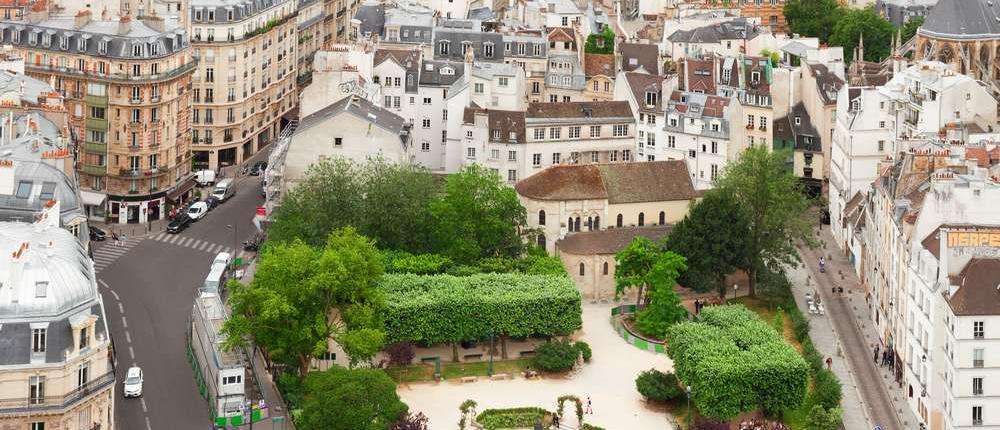The history of the Latin Quarter of Paris
Posted in Hotel le 15 December 2023

On the left bank of the Seine, the Latin Quarter is one of the oldest districts of Paris. We find its first traces in the Middle Ages, where it already housed numerous educational establishments. Even today, young people gather there to study, but also to enjoy a neighborhood with a lively and friendly atmosphere. Between Roman remains, splendid green spaces, historical monuments and great schools, discover the history of the Latin Quarter of Paris .
Why is it called the Latin Quarter?
Almost forever, the 5th and 6th arrondissements of Paris have been a dream come true with their legendary Latin Quarter . From the Sorbonne to the Luxembourg Gardens, from rue Mouffetard to the Panthéon, this little corner of Paris attracts visitors, but also and above all students. It must be said that there are many great schools there, and this has been the case since the Middle Ages.
From the 13th century, monasteries were relieved of school education and schools and universities took over. The left bank of the Seine then saw the establishment of numerous places of learning, where lessons were still taught in Latin. This district of Paris is then nicknamed the “Latin Country”.
At the end of the 18th century, the highly intellectual district took the name of "Quartier Latin", and even today, prestigious educational establishments are located there: Sorbonne University, the Collège de France, the Lycée Henri IV, the Lycée Louis Le Large, the Saint-Louis high school, the School of Fine Arts, the School of Mines, the Montaigne high school...
Our walking route in the Latin Quarter
If you are planning to stay at the Espérance hotel to discover Paris, we have prepared a short itinerary for you for a stroll in the Latin Quarter of Paris. Let's start our journey at the Luxembourg Gardens, before gradually getting closer to the hotel.
The Luxembourg Garden
Less than 20 minutes on foot from the Hôtel de l'Espérance, in the 6th arrondissement, the Luxembourg Gardens is one of the largest green spaces in the capital, with an area of 25 hectares. Composed of a French garden on the one hand, and an English garden on the other, this immense Parisian park, with its forest, its pond and its numerous statues is a green lung of Paris where it is very pleasant to walk around.
Boulevard Saint-Michel
Let's leave the park and head towards the Pantheon. Boulevard Saint-Michel stretches before us to the bridge of the same name. If the boutiques, bookstores and arthouse cinemas are appreciated, this boulevard is especially recognized for having been the seat of the student demonstrations of May 68. Here, we note the historical aspect of this major Parisian axis built by Haussmann.
Saint-Séverin church
Almost at the end of Boulevard Saint-Michel, turn right to go to the Saint-Séverin church . In the 5th arrondissement of Paris, this church was built between the 13th and 15th centuries. The facade reveals a Gothic style typical of the Middle Ages, and inside, we discover a choir surrounded by astonishing twisted columns and Gothic stained glass windows of rare beauty.
The Saint-Julien-Le-Pauvre church
A stone's throw from the Saint-Séverin church, we find a second, smaller church, the Saint-Julien-Le-Pauvre church . Built in the 12th century, this religious building is the oldest church in Paris. The charm of its architecture blends perfectly into this picturesque neighborhood, with exterior buttresses, Gothic columns and icons dating back to 1900.
Good to know: many prestigious concerts are regularly organized in the Saint-Julien-Le-Pauvre and Saint-Séverin churches.
The Cluny museum
With our backs to the Seine, we then walk towards the Cluny museum , just 300 meters from the churches via rue Saint-Jacques. The National Museum of the Middle Ages awaits us for a journey back in time. Housed in the Hôtel de Cluny, a 15th century building, the museum of the same name brings together numerous masterpieces from the medieval era.
You can also visit the Baths of Cluny , built by the Romans almost 20 centuries ago, and in particular the remains of the vast rooms dedicated to baths. Note that the ancient thermal baths of Cluny are among the best preserved monumental ancient remains in Northern Europe.
Sorbonne University
On the other side of the Cluny museum, taking rue des écoles for 250 meters, we arrive at the most prestigious university in Paris , the Sorbonne . Built by Jacques Lemercier in the 17th century, at the request of Cardinal Richelieu, this building houses the Sorbonne, a university founded in the 13th century by Pierre de Sorbon.
Before being a place of teaching arts, law and medicine , the Sorbonne was a theology college reserved for penniless students.
The pantheon
Let's now bypass the Louis Le Grand high school to go to the Sainte-Geneviève mountain , taking rue Soufflot. In this legendary Parisian district, we come face to face with the imposing Pantheon . This neo-classical mausoleum in the 5th arrondissement houses the graves of the men and women who left their mark on the French Republic.
In the monument with its gigantic dome you will discover the tombs of Pierre and Marie Curie, Victor Hugo, and Simone Veil, but you can also admire the necropolis of the Great Men and Foucault's pendulum. At the very top of the dome, Paris and its historic monuments stretch out before your eyes.
The Great Mosque of Paris
Let's resume our path, passing through the Place de la contrescarpe, to reach the Grand Mosque of Paris . Facing the Jardin des Plantes, the religious building stands out with its 33 meter high minaret. Inside, you will be surprised by the beauty and calm of the place. This is the perfect opportunity to stop off on our walk, offering yourself a little hammam, tea or a little treat.
Built in the 1920s, the Grand Mosque of Paris is accessible to all, for a peaceful moment in a bubble of sweetness.
The Arab World Institute
Let's now bypass the Marie and Pierre Curie campus of the Sorbonne, heading towards the banks of the Seine. Here, you will easily recognize the Arab World Institute by its metal facade prettily decorated with moucharabieh.
Designed by the architect Jean Nouvel, this space dedicated to Arab civilization offers a vast program of shows and exhibitions and conferences.
Good to know: from the institute's terrace, you can admire a breathtaking view of the Île de la Cité and Notre-Dame de Paris cathedral.
Garden plants
Let's continue our walk to the Jardin des Plantes , rue Cuvier, in the 5th arrondissement. This 24-hectare French garden is a haven of peace for walkers. The fauna and flora flourish there serenely, while the Grandes Serres reveal the biodiversity of different regions of the world: the vegetation of New Caledonia, the jungle, the flora of the desert... You can also discover the Menagerie there. of the Jardin des Plantes , with its 600 animals of 150 different species.
Initially, the Jardin des Plantes was laid out by Louis XIII, in the 17th century, with the aim of training future apothecaries and doctors.
The National Museum of Natural History
Let's end our journey with the National Museum of Natural History . Located in the Jardin des Plantes, it is made up of several galleries, including the very famous Grande Galerie de l'Évolution, which presents 7,000 specimens of stuffed animals, but also the Gallery of Mineralogy and Geology, and the Gallery of Paleonthology and of Comparative Anatomy.
Located in the heart of the Latin Quarter, the Hôtel de l'Espérance is the ideal starting point for all your next visits to this historic district of the capital. Put on good shoes, and keep your eyes peeled!
